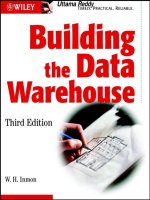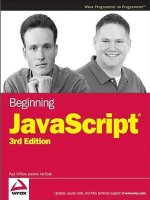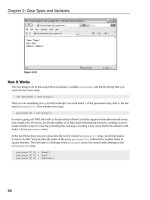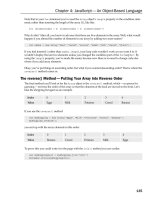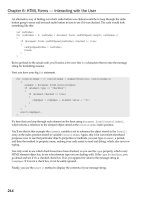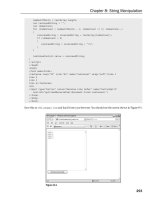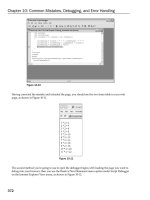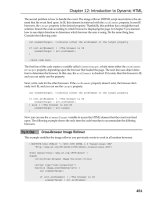Beginning Perl Third Edition PHẦN 1 potx
Bạn đang xem bản rút gọn của tài liệu. Xem và tải ngay bản đầy đủ của tài liệu tại đây (6.5 MB, 47 trang )
Lee
Perl
Companion
eBook Available
Beginning
James Lee, Author of
Hacking Linux Exposed
this print for content only—size & color not accurate
CYAN
MAGENTA
YELLOW
BLACK
PANTONE 123 C
BOOKS FOR PROFESSIONALS BY PROFESSIONALS
®
Beginning Perl
Dear Reader,
Whether you are a complete novice or an experienced programmer, you hold
in your hands the ideal guide to learning Perl. Originally created as a powerful
text processing tool, Perl has since evolved into a multipurpose, multiplatform
programming language capable of implementing a variety of tasks such as
system administration, web and network programming, and XML processing.
In this book I will provide valuable insight into Perl's role regarding several of
these tasks and more.
Starting with a comprehensive overview of the basics of Perl, I'll introduce
important concepts such as Perl's data types and control flow constructs. This
material sets the stage for a discussion of more complex topics, such as writing
custom functions, using regular expressions, and file input and output.
Next, we move on to the advanced topics of object-oriented programming,
modules, CGI programming, and database administration with Perl's powerful
database interface module, DBI. The examples and code provided offer you all
of the information you need to start writing your own powerful scripts to solve
the problems listed above, and many more.
After years of experience programming in this powerful language, I've come
to appreciate Perl's versatility and functionality for solving simple and highly
complex problems alike. Plus, Perl is one of the most enjoyable languages to
use—programming in Perl is fun! I am confident that once you have studied the
material covered in this book, you'll feel the same.
James Lee
US $39.99
Shelve in:
Perl
User level:
Beginning
www.apress.com
SOURCE CODE ONLINE
Companion eBook
See last page for details
on $10 eBook version
ISBN 978-1-4302-2793-9
9 781430 227939
5 39 9 9
THE APRESS ROADMAP
The Definitive Guide
to Catalyst
Pro Perl
Linux System
Administration
Recipes
Beginning Perl
3rd Ed
Beginning
Portable Shell Scripting
Covers
Perl 5.10
THIRD
EDITION
7.5 x 9.25 spine = 0.875" 464 page count
THE EXPERT’S VOICE
®
IN OPEN SOURCE
Perl
THIRD EDITION
James Lee
Perl for those who missed it the first time around:
Learn about the duct tape for the web, the cloud
and system administration
Beginning
Covers
Perl 5.10
Beginning Perl
Third Edition
■ ■ ■
JAMES LEE
with SIMON COZENS
www.wowebook.com
ii
Beginning Perl, Third Edtion
Copyright © 2010 by James Lee
All rights reserved. No part of this work may be reproduced or transmitted in any form or by any
means, electronic or mechanical, including photocopying, recording, or by any information
storage or retrieval system, without the prior written permission of the copyright owner and the
publisher.
ISBN-13 (pbk): 978-1-4302-2793-9
ISBN-13 (electronic): 978-1-4302-2794-6
Printed and bound in the United States of America 9 8 7 6 5 4 3 2 1
Trademarked names may appear in this book. Rather than use a trademark symbol with every
occurrence of a trademarked name, we use the names only in an editorial fashion and to the
benefit of the trademark owner, with no intention of infringement of the trademark.
President and Publisher: Paul Manning
Lead Editor: Frank Pohlmann
Technical Reviewers: Richard Dice, Ed Schaefer, Todd Shandelman
Editorial Board: Clay Andres, Steve Anglin, Mark Beckner, Ewan Buckingham, Gary Cornell,
Jonathan Gennick, Jonathan Hassell, Michelle Lowman, Matthew Moodie, Duncan Parkes,
Jeffrey Pepper, Frank Pohlmann, Douglas Pundick, Ben Renow-Clarke, Dominic
Shakeshaft, Matt Wade, Tom Welsh
Coordinating Editor: Laurin Becker
Copy Editors: Katie Stence, Sharon Terdeman
Compositor: Kimberly Burton
Indexer: Brenda Miller
Artist: April Milne
Cover Designer: Anna Ishchenko
Distributed to the book trade worldwide by Springer-Verlag New York, Inc., 233 Spring Street, 6th
Floor, New York, NY 10013. Phone 1-800-SPRINGER, fax 201-348-4505, e-mail orders-ny@springer-
sbm.com, or visit www.springeronline.com.
For information on translations, please e-mail
, or visit www.apress.com.
Apress and friends of ED books may be purchased in bulk for academic, corporate, or promotional
use. eBook versions and licenses are also available for most titles. For more information, reference
our Special Bulk Sales–eBook Licensing web page at www.apress.com/info/bulksales.
The information in this book is distributed on an “as is” basis, without warranty. Although every
precaution has been taken in the preparation of this work, neither the author(s) nor Apress shall
have any liability to any person or entity with respect to any loss or damage caused or alleged to be
caused directly or indirectly by the information contained in this work.
The source code for this book is available to readers at www.apress.com. You will need to answer
questions pertaining to this book in order to successfully download the code.
iii
For Polly and Dave Pistole
i
v
Contents at a Glance
■About the Author xvi
■About the Technical Reviewers xvii
■Acknowledgements xviii
■Introduction xix
■Chapter 1: First Steps in Perl 1
■Chapter 2: Scalars 13
■Chapter 3: Control Flow Constructs 53
■Chapter 4: Lists and Arrays 81
■Chapter 5: Hashes 115
■Chapter 6: Subroutines/Functions 131
■Chapter 7: Regular Expressions 153
■Chapter 8: Files and Data 179
■Chapter 9: String Processing 207
■Chapter 10: Interfacing to the Operating System 215
■Chapter 11: References 231
■Chapter 12: Modules 257
■Chapter 13: Object-Oriented Perl 287
■Chapter 14: Introduction to CGI 317
■Chapter 15: Perl and DBI 349
■Appendix: Exercise Solutions 387
■Index 409
v
Contents
■About the Author xvi
■About the Technical Reviewers xvii
■Acknowledgements xviii
■Introduction xix
■Chapter 1: First Steps in Perl 1
Programming Languages 1
Our First Perl Program 2
Program Structure 6
Character Sets 8
Escape Sequences 8
Whitespace 9
Number Systems 9
The Perl Debugger 11
Summary 11
Exercises 12
■Chapter 2: Scalars 13
Types of Data 13
Numbers 14
Strings 17
Here-Documents 20
Converting Between Numbers and Strings 21
■ CONTENTS
CONTENTS
vi
Operators 22
Numeric Operators 22
String Operators 32
Operators to Be Covered Later 36
Operator Precedence 37
Variables 38
Scoping 43
Variable Names 46
Variable Interpolation 46
Currency Converter 48
Two Miscellaneous Functions 50
The exit() Function 50
The die() Function 51
Summary 52
Exercises 52
■Chapter 3: Control Flow Constructs 53
The if Statement 54
Operators Revisited 55
Multiple Choice: if . . . else 61
The unless Statement 64
Expression Modifiers 65
Using Short-Circuited Evaluation 65
Looping Constructs 66
The while Loop 66
while (<STDIN>) 67
Infinite Loops 69
Looping Until 70
The for Loop 71
■ CONTENTS
vii
The foreach Loop 71
do while and do until 72
Loop Control Constructs 74
Breaking Out 74
Going On to the Next 75
Reexecuting the Loop 76
Loop Labels 77
goto 79
Summary 79
Exercises 79
■Chapter 4: Lists and Arrays 81
Lists 81
Simple Lists 82
More Complex Lists 83
Creating Lists Easily with qw// 84
Accessing List Values 87
Arrays 91
Assigning Arrays 91
Scalar vs. List Context 94
Adding to an Array 95
Accessing an Array 95
Summary 114
Exercises 114
■Chapter 5: Hashes 115
Creating a Hash 115
Working with Hash Values 117
Hash in List Context 119
■ CONTENTS
CONTENTS
viii
Hash in Scalar Context 120
Hash Functions 121
The keys() Function 121
The values() Function 122
The each() Function 123
The delete() Function 123
The exists() Function 124
Hash Examples 125
Creating Readable Variables 125
“Reversing” Information 125
Counting Things 126
Summary 129
Exercises 129
■Chapter 6: Subroutines/Functions 131
Understanding Subroutines 132
Defining a Subroutine 132
Invoking a Subroutine 133
Order of Declaration and Invoking Functions 134
Passing Arguments into Functions 137
Return Values 139
The return Statement 141
Understanding Scope 142
Global Variables 142
Introduction to Packages 144
Lexical Variables (aka Local Variables) 146
Some Important Notes on Passing Arguments 147
Function Arguments Passed by Reference 147
Lists Are One-Dimensional 149
■ CONTENTS
ix
Default Argument Values 150
Named Parameters 151
Summary 152
Exercises 152
■Chapter 7: Regular Expressions 153
What Are They? 153
Patterns 154
Working with Regexes 170
Substitution 170
Changing Delimiters 172
Modifiers 173
The split() Function 174
The join() Function 175
Common Blunders 175
Summary 176
Exercises 177
■Chapter 8: Files and Data 179
Filehandles 179
The open() Function 179
The close() Function 180
Three Ways to Open a File 181
Read Mode 182
Reading in Scalar Context 183
Reading with the Diamond 185
@ARGV: The Command-Line Arguments 187
@ARGV and <> 189
$ARGV 190
Reading in List Context 190
■ CONTENTS
CONTENTS
x
Writing to Files 192
Buffering 195
Opening Pipes 196
Receiving Piped Data from a Process 196
Sending Piped Data to Another Process 198
Bidirectional Pipes 200
File Tests 200
Summary 205
Exercises 205
■Chapter 9: String Processing 207
Character Position 207
String Functions 208
The length() Function 208
The index() Function 208
The rindex() Function 210
The substr() Function 210
Transliteration 212
Summary 213
Exercises 213
■Chapter 10: Interfacing to the Operating System 215
The %ENV Hash 215
Working with Files and Directories 217
File Globbing with glob() 217
Reading Directories 220
Functions to Work with Files and Directories 221
Executing External Programs 225
The system() Function 225
■ CONTENTS
xi
Backquotes 227
There’s More 228
Summary 228
Exercises 229
■Chapter 11: References 231
What Is a Reference? 231
Anonymity 232
The Life Cycle of a Reference 232
Reference Creation 232
Reference Modification 239
Reference Counting and Destruction 243
Using References for Complex Data Structures 244
Matrices 245
Autovivification 245
Trees 250
Summary 255
Exercises 255
■Chapter 12: Modules 257
Why Do We Need Them? 257
Creating a Module 258
Including Other Files with use 260
do 260
require 261
use 262
Changing @INC 262
Package Hierarchies 263
Exporters 265
■ CONTENTS
CONTENTS
xii
The Perl Standard Modules 267
Online Documentation 268
Data::Dumper 268
File::Find 270
Getopt::Std 271
Getopt::Long 272
File::Spec 273
Benchmark 275
Win32 276
CPAN 278
Installing Modules with PPM 280
Installing a Module Manually 281
The CPAN Module 281
Bundles 284
Submitting Your Own Module to CPAN 285
Summary 286
■Chapter 13: Object-Oriented Perl 287
OO Buzzwords 287
Objects 287
Attributes 288
Methods 288
Classes 289
Polymorphism 290
Encapsulation 290
Inheritance 290
Constructors 291
Destructors 292
An Example 292
■ CONTENTS
xiii
Rolling Your Own Classes 295
Bless You, My Reference 296
Storing Attributes 298
The Constructor 298
Creating Methods 301
Do You Need OO? 313
Are Your Subroutines Tasks? 314
Do You Need Persistence? 314
Do You Need Sessions? 314
Do You Need Speed? 314
Do You Want the User to Be Unaware of the Object? 314
Are You Still Unsure? 314
Summary 315
Exercises 315
■Chapter 14: Introduction to CGI 317
We Need a Web Server 318
Creating a CGI Directory 318
Writing CGI Programs 318
“hello, world!” in CGI 319
The CGI Environment 321
Generating HTML 323
Introducing CGI.pm 325
Conventional Style of Calling Methods 331
CGI.pm Methods 332
Methods That Generate Several Tags 332
Methods That Generate One Tag 333
Processing Form Data 333
The param() Method 335
■ CONTENTS
CONTENTS
xiv
Dynamic CGI 336
Let’s Play Chess! 338
Improvements We Can Make 346
What We Did Not Talk About 347
Summary 348
Exercises 348
■Chapter 15: Perl and DBI 349
Introduction to Relational Databases 349
We Need an SQL Server—MySQL 353
Testing the MySQL Server 353
Creating a Database 354
Creating a Non-root User with the GRANT Command 357
The INSERT Command 358
The SELECT Command 361
Table Joins 367
Introduction to DBI 368
Installing DBI and the DBD::mysql 368
Connecting to the MySQL Database 369
Executing an SQL Query with DBI 370
A More Complex Example 372
Use Placeholders 375
DBI and Table Joins 377
Perl, DBI, and CGI 378
What We Didn’t Talk About 385
Summary 386
Exercises 386
■Appendix: Exercise Solutions 387
■ CONTENTS
xv
Chapter 1 387
Chapter 2 387
Chapter 3 389
Chapter 4 390
Chapter 5 391
Chapter 6 393
Chapter 7 395
Chapter 8 396
Chapter 9 398
Chapter 10 399
Chapter 11 400
Chapter 13 404
Chapter 14 405
Chapter 15 406
■ Index 409
■ CONTENTS
CONTENTS
xvi
About the Author
■James Lee is a hacker and open-source advocate based in Illinois. He
has a master’s degree from Northwestern University, where he can often
be seen rooting for the Wildcats during football season. The founder of
Onsight, James has worked as a programmer, trainer, manager, writer,
and open-source advocate. He is the author of Open Source Web
Development with LAMP (Addison-Wesley), and a coauthor of Hacking
Linux Exposed, Second Edition (McGraw-Hill/Osborne). He has also
written a number of articles on Perl for Linux Journal. James enjoys
hacking Perl, developing software for the Web, snowboarding, listening
to music on his iPod, reading, traveling, and most of all, playing with his
kids, who are now old enough to know why Dad’s favorite animals are
penguins and camels. You can reach him at
■ CONTENTS
xvii
About the Technical Reviewers
■Richard Dice has more than 15 years of experience in the IT industry in
many different roles: he has been a software developer, manager of
software development groups, and IT director with full responsibility for IT
operations and customer deliverables in various operating companies.
Richard has also been a IT consultant and corporate technology trainer to
internationally recognizable organizations including Intel, Motorola and
Unisys. He is an author and frequent speaker at industry conferences.
Richard is also the past president of The Perl Foundation, the global
organizing body that represented the Perl open-source programming
language. Richard has a B.Sc. in Applied Mathematics from the University
of Western Ontario and an MBA from the University of Toronto.
■Ed Schaefer is an ex-paratrooper, an ex-military intelligence officer, an ex-
oil-field-service engineer, and a past contributing editor and columnist for
Sys Admin, the Journal of Unix System Administrators. He's not a total has-
been. He's earned a BSEE from South Dakota School of Mines & Technology,
and a MBA from USD. Presently, he fixes microstrategy and teradata
problems—with an occasional foray into Linux—for a Fortune 50 company.
■Todd Shandelman, who fondly remembers coding assembly language
programs on punchcards for IBM System/370 mainframes, has been an
ardent Perl devotee since the days of Perl 4. After occupying various other
ecological niches in software technology over the years (C, C++, and Java, to
name but a few), Todd has now settled comfortably into a mostly-Perl milieu.
In his spare time a professional translator of Russian and Hebrew, he also
enjoys studying Mandarin Chinese—as a sort of reminder of just how easy
learning Perl really is! Todd earned a bachelor of science degree in business
administration from the State University of New York and currently lives in
Brookline, Massachusetts.
■ CONTENTS
CONTENTS
xviii
Acknowledgments
I want to start by saying thanks to Simon Cozens for writing an excellent book that I had the privilege of
revising, again, for this latest edition. You set the bar extremely high—I hope that my work has not
lowered it.
Luckily, I had great tech editors: Richard Dice, Ed Schaefer and Todd Shandelman. Thanks for all your
excellent input.
This book is better because of your hard work. Any mistakes that remain are all mine.
You folks at Apress are great, especially Frank Pohlmann, Laurin Becker and Fran Parnell. And thanks to
Katie Stence and Sharon Terdeman for the copy editing. You all were a pleasure to work with.
Deep appreciation to Larry Wall for creating Perl; the language that has brought me great joy for the last
16 years. I don’t think I would like my job as much if I never had Perl to play with. Thanks also to the Perl
community for all the selfless work making Perl what it is, especially Lincoln Stein for CGI.pm and Tim
Bunce for DBI.
Lastly, thanks to those in my life who help make it worth living: my family and all my friends—I’d list you
all by name, but I have no idea who to start with (actually, I do know who to start with). Besides, you
know who you are.
xi
x
Introduction
Perl was originally written by Larry Wall while he was working at NASA’s Jet Propulsion Labs. Larry is an
Internet legend, known not just for Perl, but as the author of the UNIX utilities rn, one of the original
Usenet newsreaders, and patch, a tremendously useful tool that takes a list of differences between two
files and allows you to turn one into the other. The term patch used for this activity is now widespread.
Perl started life as a “glue” language for Larry and his officemates, allowing one to “stick” different
tools together by converting between their various data formats. It pulled together the best features of
several languages: the powerful regular expressions from sed (the Unix stream editor), the pattern-
scanning language awk, and a few other languages and utilities. The syntax was further made up out of
C, Pascal, Basic, Unix shell languages, English, and maybe a few other elements along the way.
While Perl started its life as glue, it is now more often likened to another handy multiuse tool: duct
tape. A common statement heard in cyberspace is that Perl is the duct tape that holds the Internet
together.
Version 1 of Perl hit the world on December 18, 1987 and the language has been steadily evolving
since then, with contributions from a whole bunch of people (see the file AUTHORS in the latest stable
release tarball). Perl 2 expanded regular expression support, while Perl 3 enabled the language to deal
with binary data. Perl 4 was released so that the “Camel Book” (also known as Programming Perl by
Larry Wall [O'Reilly & Associates, 2000]) could refer to a new version of Perl.
Perl 5 has seen some rather drastic changes in syntax, and some pretty fantastic extensions to the
language. Perl 5 is (more or less) backwardly compatible with previous versions of the language, but at
the same time makes a lot of the old code obsolete. Perl 4 code may still run, but Perl 4 style is definitely
frowned upon these days.
At the time of writing, the current stable release of Perl is 5.10.1, which is what this book will
describe. That said, the maintainers of Perl are very careful to ensure that old code will run, perhaps all
the way back to Perl 1—changes and features that break existing programs are evaluated extremely
seriously. Everything you see here will continue to function in the future.
We say “maintainers” because Larry no longer looks after Perl by himself—a group of “porters”
maintains the language and produces new releases. The perl5-porters mailing list is the main
development list for the language, and you can see the discussions archived at
www.xray.mpe.mpg.de/mailing-lists/perl5-porters. For each release, one of the porters will carry the
“patch pumpkin”—the responsibility for putting together and releasing the next version of Perl.
The Future of Perl—Developers Releases and Perl 6
Perl is a living language, and it continues to be developed and improved. The development happens on
two fronts. Stable releases of Perl, intended for the general public, have a version number x.y.z where z is
less than 50. Currently, we’re at 5.10.1; the next major stable release is going to be 5.12.0 (if there is
another major release before version 6.0.0). Cases where z is more than 0 are maintenance releases
issued to fix any overwhelming bugs. This happens extremely infrequently—for example, the 5.5 series
had three maintenance releases in approximately a year of service.
■ INTRODUCTION
xx
Between stable releases, the porters work on the development track (where y is odd); when 5.8.0 was
released, work began on 5.9.0 (the development track) to eventually become 5.10.0. Naturally, releases
on the development track happen much more frequently than those on the stable track, but don’t think
you need to use a development version of Perl to get the latest and greatest features, or just because your
stable version from last year seems old in comparison to the bright and shiny Perl released last week—no
guarantees whatsoever are made about a development release of Perl. Releases are coordinated by a
“patch pumpkin holder,” or “pumpking”—a programmer of discernment and taste who, with help from
Larry, decides which contributions make the grade and when, and bears the heavy responsibility of
releasing a new Perl to the world. They maintain the most current and official source to Perl, which they
sometimes make available to the public.
Why a pumpkin? To allow people to work on various areas of Perl at the same time and to avoid two
people changing the same area in different ways, one person has to take responsibility for bits of
development, and all changes must go through that person. Hence, the person who has the patch
pumpkin is the only person who is allowed to make the change. Chip Salzenburg explains: “David Croy
once told me that at a previous job, there was one tape drive and multiple systems that used it for
backups. But instead of some high-tech exclusion software, they used a low-tech method to prevent
multiple simultaneous backups: a stuffed pumpkin. No one was allowed to make backups unless they
had the ‘backup pumpkin.’”
So what development happens? As well as bug fixes, the main focus of development is to allow Perl
to build more easily on a wider range of computers and to make better use of what the operating system
and the hardware provides—support for 64-bit processors, for example. The Perl compiler is steadily
getting more useful but still has a way to go. There’s also a range of optimizations to be done to make
Perl faster and more efficient, and work progresses to provide more helpful and more accurate
documentation. Finally, there are a few enhancements to Perl syntax that are being debated—the Todo
file in the Perl source kit explains what’s currently on the table.
Perl 6
The future of Perl lies in Perl 6, a complete rewrite of the language. The purpose of Perl 6 is to address the
problems with Perl 5 and to create a language that can continue to grow and change in the future. Larry
Wall has this to say about Perl 6:
Perl 5 was my rewrite of Perl. I want Perl 6 to be the community’s rewrite of Perl and of the
community.
There are several changes to the Perl language that are in the works for Perl 6, including enhanced
regular expression syntax, more powerful function definitions, some improvements to the constructs
(including the addition of a switch statement), new object-oriented syntax, and more. Stay tuned for
more information—it is definitely a work in progress.
A big change in Perl 6 will be the introduction of Rakudo () which is based on
Parrot (). Rakudo is the new runtime environment that is being developed
from scratch for Perl 6, but it will not be limited to Perl 6—any bytecode-compiled language such as Tcl
and Python can use it.
You can read all about the future of Perl at and
Stay informed, and get involved!
Why Perl?
The name “Perl” isn’t really an acronym. People like making up acronyms though, and Larry has two
favorite expansions. Perl is, according to its creator, the Practical Extraction and Report Language, or the
■ INTRODUCTION
xxi
Pathologically Eclectic Rubbish Lister. Either way, it doesn’t really matter. Perl is a language for doing
what you want to do easily and quickly.
The Perl motto is “There’s More Than One Way To Do It,” emphasizing both the flexibility of Perl
and the fact that Perl is about getting the job done. This motto is so important someone has created an
acronym for it: TMTOWTDI (pronounced “TimToeDee”). This acronym comes up again and again in
this book since we often talk about many ways of doing the same thing. We can say that one Perl
program is faster, or more idiomatic, or more efficient than another, but if both do the same thing, Perl
isn’t going to judge which one is “better.” It also means that you don’t need to know every last little
detail about the language in order to do what you want with it. You’ll probably be able to achieve many
of the tasks you might want to use Perl for after the first four or five chapters of this book.
Perl has some very obvious strengths:
• It’s easy to learn, and learning a little Perl can take you a long way. Perl is a lot like
English in this regard—you don’t need to know a lot of English to get your point
across (as demonstrated by a three-year-old who wants a particular toy for her
birthday), but if you know quite a bit about the English language, you can say a lot
with a little.
• Perl was designed to be easy for humans to write, rather than easy for computers
to understand. The syntax of the language is a lot more like a human language
than the strict, rigid grammars and structures of other languages, and so it doesn’t
impose any particular way of thinking on you.
• Perl is very portable. That means what it sounds like—you can pick up a Perl
program and carry it from one computer to another. Perl is available for a huge
range of operating systems and computers, and properly written programs should
be able to run almost anywhere that Perl does without any change.
• Perl talks text. It can think about words and sentences, where other languages see
a character at a time. It can think about files in terms of lines, not individual bytes.
Its regular expressions allow you to search for and transform text in innumerable
ways with ease and speed.
• Perl is what is termed a “high-level language.” Some languages like C concern you
with unnecessary, low-level details about the computer’s operation: making sure
you have enough free memory, making sure all parts of your program are set up
properly before you try to use them, and leaving you with strange and unfriendly
errors if you don’t do so. Perl cuts you free from all this.
However, since Perl is so easy to learn and to use, especially for quick little administrative tasks,
“real” Perl users in practice tend to write programs to achieve small, specific jobs. In these cases, the
code is meant to have a short lifespan, and be for the programmer’s eyes only. The result is often a
cryptic one-liner that is incomprehensible to everyone but the original programmer (and sometimes
incomprehensible to him a year later). The problem is, these programs may live a little longer than the
programmer expects, and be seen by other eyes as well. Because of the proliferation of these rather
concise and confusing programs, Perl has developed a reputation for being arcane and unintelligible,
one that will hopefully be dispelled during the course of this book.
For starters, this reputation is unfair. It’s possible to write code that is tortuous and difficult to
follow in any programming language, and Perl was never meant to be difficult. In fact, one could say that
Perl is one of the easiest languages to learn, especially given its scope and flexibility.
Throughout this book you’ll find examples showing you how to avoid the stereotypical “spaghetti
code” and how to write programs that are both easy to write and easy to follow.
■ INTRODUCTION
xxii
It’s Open Source
Larry started (and indeed, continued) Perl with the strong belief that software should be free—freely
available, freely modifiable, and freely distributable. It is part of a collection of programs known as open
source (see for details). Perl is developed and maintained by the porters,
who are volunteers from the Perl user community, all of who strive to make Perl as useful as possible.
This has a few nice side effects—the porters are working for love, rather than merely because it’s
their job, so they’re motivated solely by their desire to see a better Perl. It also means Perl will continue
to be free to use and distribute.
This doesn’t mean that Perl is part of the GNU suite of utilities. The GNU project was set up to
produce a freely usable, distributable, and modifiable version of the Unix operating system and its tools,
and now produces a lot of helpful, free utilities. Perl is included in distributions of GNU software, but
Perl itself is not a product of the Free Software Foundation, the body that oversees GNU.
While Perl can be distributed under the terms of the GNU Public License (which you can find at
), it can also be distributed under the Artistic License (found either with the Perl
sources or at which purports to give more freedom to users and
more security to developers than the GPL.
Of course, those wanting to use Perl at work might be a little put off by this—managers like to pay
money for things and have pieces of paper saying that they can get irate at someone if it all stops
working. There’s a question in the Perl Frequently Asked Questions (FAQ) about how to get a
commercial version or support for Perl, and we’ll see how you can find out the answer for yourself pretty
soon.
When we say, “anyone can help” with Perl, we don’t mean anyone who can understand the whole of
the Perl source code. Of course, people who can knuckle down and attack the source files are useful, but
equally useful work is done by the army of volunteers who offer their services as testers, documenters,
proofreaders, and so on. Anyone who can take the time to check the spelling or grammar of some of the
core documentation can help, as can anyone who can think of a new way of explaining a concept, or
anyone who can come up with a more helpful example for a function.
Perl development is done in the open, on the perl5-porters mailing list. The perlbug program,
shipped with Perl, can be used to report problems to the list, but it’s a good idea to check with someone
first to make sure that it really is a problem and that it isn’t fixed in a later or development release of Perl.
Perl on the Web and the Network
One of the most popular uses of Perl is CGI programming—that is, dynamically generating web pages.
This is introduced in Chapter 14. Perl is the power behind some of the most popular sites on the Web:
Slashdot (), Amazon (), and many others are almost
entirely Perl-driven.
Of course, Perl is still widely used for its original purpose: extracting data from one source and
translating it to another format. This covers everything from processing and summarizing system logs,
through manipulating databases, reformatting text files, and simple search-and-replace operations, to
something like alien, a program to port Linux software packages between different distributors’
packaging formats. Perl even manages the data from the Human Genome Project, a task requiring
massive amounts of data manipulation.
For system administrators, Perl is certainly the “Swiss Army chainsaw” that it claims to be. It’s great
for automating administration tasks, sending automatically generated mail, and generally tidying up the
system. It can process logs, report information on disk usage, produce reports on resource use, and
watch for security problems. There are also extensions that allow Perl to deal with the Windows registry
■ INTRODUCTION
xxiii
and run as a Windows service, not to mention built-in functions that enable it to manipulate UNIX
passwd and group file entries.
However, as you might expect, that’s not all. Perl is becoming the de facto programming language of
the Internet—its networking capabilities have allowed it to be used to create clients, servers, and proxies
for standards such as IRC, WWW, FTP, and practically every other protocol you can think of. It’s used to
filter mail, automatically post news articles, mirror websites, automate downloading and uploading, and
so on. In fact, it’s hard to find an area of the Internet where Perl isn’t used. This is kind of like duct tape,
really. When was the last time you used duct tape to tape a duct?
Windows, Unix, and Other Operating Systems
Perl is one of the most portable, if not the most portable, programming languages around. It can be
compiled on over 70 operating systems, and you can get binary distributions for most common
platforms. Most of the programs in this book can run equally well on almost any operating system.
When we’re setting up Perl and running our examples, we’ll concentrate particularly on Unix and
Windows. The term Unix here refers to any commercial or free Unix-like implementation—Solaris;
Linux; Net-, Free-, and OpenBSD; HP/UX; A/IX; and so on. Perl’s home platform is Unix, and 90% of the
world uses Windows. That said, Perl is the same for everyone. If you need help with your particular
platform, you can probably find a README file for it in the Perl source distribution.
You can also get more information on portable Perl programming from the perlport
documentation. Again, you’ll see how to access this documentation very soon.
Program Names
Perl doesn’t care what we programmers name our scripts, but this book uses the conventional file
extension .pl. For instance, one of our first programs will be named helloworld.pl.
The Prompt
If you’re primarily using your computer in a graphical environment like Windows or X, you may not be
familiar with using the command-line interface, or shell. Before those graphical environments came into
common use, users had to start a new program not by finding its icon and clicking it but by typing its
name. The shell is the program that takes the name from you—the shell prompt (or just prompt) refers
specifically to the text that prompts you to enter a new program name, and also more generally to
working with the shell instead of using a graphical interface. Some people still find working with the
shell much easier, and sophisticated shells have developed to simplify common tasks. In fact, on Unix,
the shell is programmable, and Perl takes some of its inspiration from standard “Bourne Shell”
programming practices.
To get to a prompt in Windows, look for Command Prompt or DOS Prompt in the Start menu. Unix
users should look for a program called something like console, terminal, konsole, xterm, eterm, or kterm.
You’ll then typically be faced with a black screen displaying a small amount of text that looks something
like one of the following:
$
%
C:\>
#
bash$

